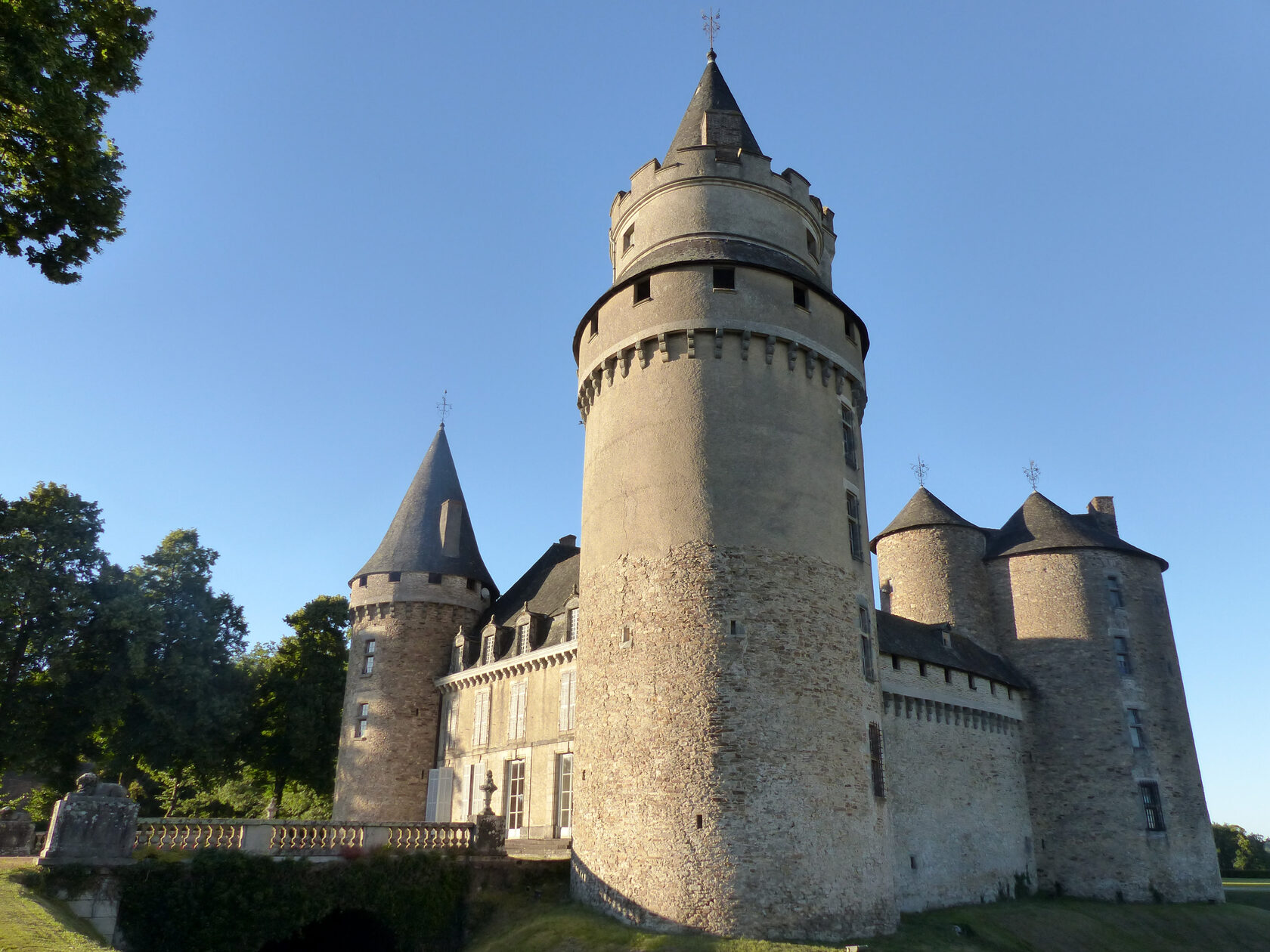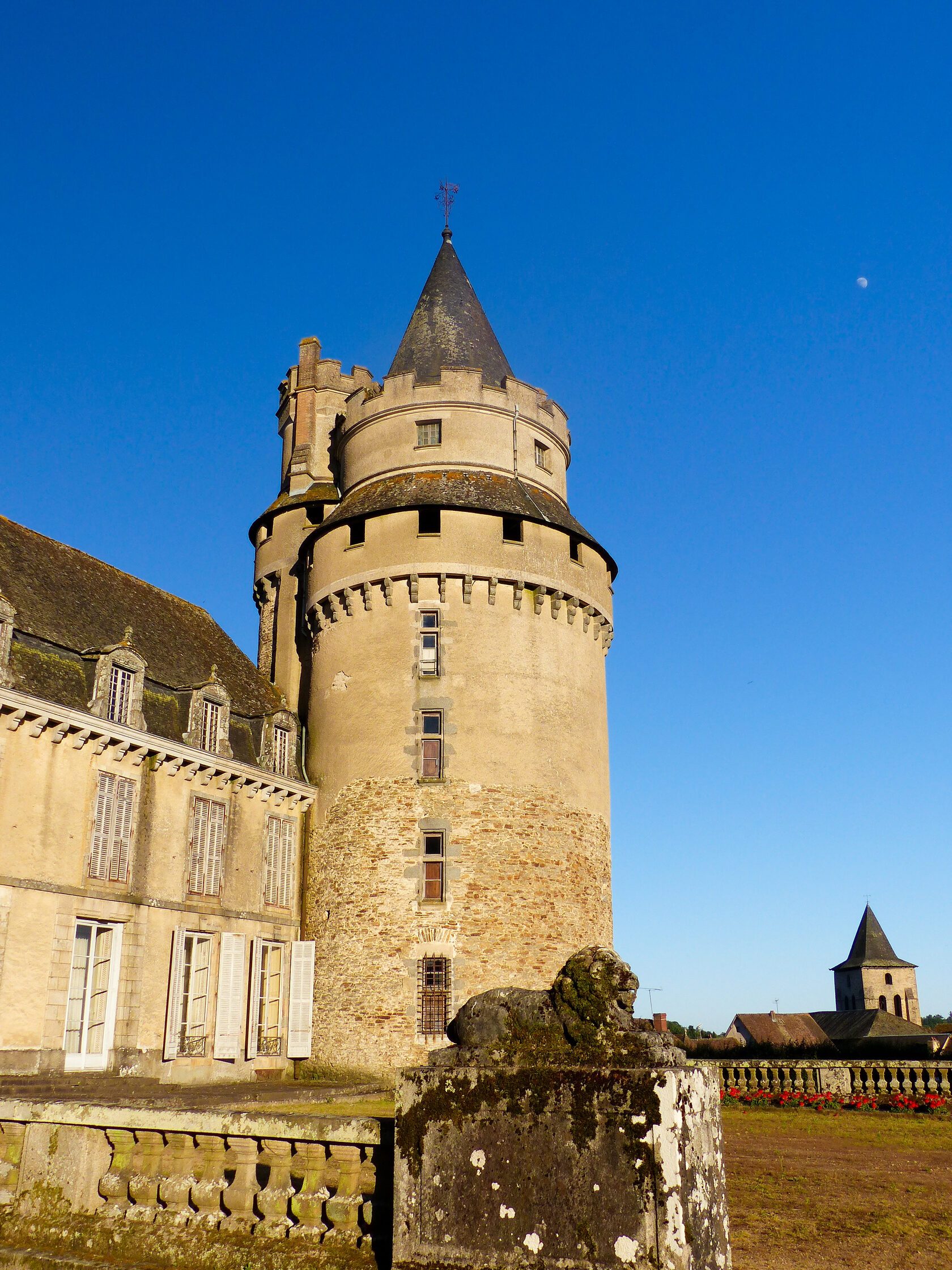Chateau de Bonneval
Marta de Bonneval runs her family chateau - an authentic XIV century fortress, once "visited" by the devil!
This website uses cookies to ensure you get the best experience.
Here are the Terms of Use and Privacy Policy
Here are the Terms of Use and Privacy Policy
OK

Geraud and Marta de Bonneval, the owners of Chateau de Bonneval
I'm talking with Marta de Bonneval who along with her husband Geraud are the owners of Chateau de Bonneval in Haute-Vienne, New Aquitanie, France. Being a descendant of Claude Alexandre de Bonneval, who served the French king, the House of Habsburg and even the Turks, she inherited the centuries old chateau in the mid-1990s. Marta told me she was happy because she got a well-maintained castle, which has preserved all the features of a proper fortress like the 4m-wide stone walls, tall towers with arrow loops, crenulations, and machicolations. She also shared with me an old legend about the devil who turned at the gates of the chateau one night in the guise of a vagabond lord but was exposed!

HOME OF BONNEVAL-PACHA
Castles and Palaces (CnP): Chateau de Bonneval is quite special among other castles – the first castle was built here in the X century and it still belongs to your family! What do you feel?
Marta de Bonneval (M.B.): The chateau has been in the family for almost a thousand years, it is an honor and a privilege to carry this legacy. Naturally, it is also a great responsibility.
Marta de Bonneval (M.B.): The chateau has been in the family for almost a thousand years, it is an honor and a privilege to carry this legacy. Naturally, it is also a great responsibility.
CnP: Have you always lived here at Bonneval?
M.B.: Well, my husband and I met in Brazil in the 1980s and we moved to France a few years later with our two children. By the late 1990s we moved into the chateau and took over the estate.
M.B.: Well, my husband and I met in Brazil in the 1980s and we moved to France a few years later with our two children. By the late 1990s we moved into the chateau and took over the estate.

CnP: An outstanding person Claude Alexandre de Bonneval is among your ancestors. A remarkable personality he had such an unbelievable life, didn't he?
M.B.: Absolutely! Claude Alexandre was born here in the chateau in 1675 and somehow you can still feel his presence in his room. He served the French king and then the House of Habsburg and later he converted to Islam and did service to the Ottoman Empire – he was even known as Bonneval-Pacha. He is undeniably a remarkable military figure of the XVIII century French and European history too. I would say he was one of the most charismatic and successful men of his time!
M.B.: Absolutely! Claude Alexandre was born here in the chateau in 1675 and somehow you can still feel his presence in his room. He served the French king and then the House of Habsburg and later he converted to Islam and did service to the Ottoman Empire – he was even known as Bonneval-Pacha. He is undeniably a remarkable military figure of the XVIII century French and European history too. I would say he was one of the most charismatic and successful men of his time!

CnP: The last large-scale restoration occurred in the 1900s but maintaining any castle is a great burden, it requires a lot of money, time, other resources – what are the challenges you face in Chateau de Bonneval?
M.B.: The greatest challenge is to continually think of and implement solutions, both innovative and creative, to ensure the safeguard of the family heritage.
M.B.: The greatest challenge is to continually think of and implement solutions, both innovative and creative, to ensure the safeguard of the family heritage.
A Danish couple restoring a XVI chateau in the hills of Dordogne
CnP: Some say that inheriting a chateau in France is a curse – do you agree and why?
M.B.: No, I could never agree. It is a blessing. That is not to say that it does not come without cerain challenges; luckily, we inherited a home, not a ruin.
M.B.: No, I could never agree. It is a blessing. That is not to say that it does not come without cerain challenges; luckily, we inherited a home, not a ruin.

CnP: The chateau looks perfect – this is true! The medieval defenses are still intact. Normally castles got rid of them as they evolve and the fortifications become unnecessary. How come the chateau still has them?
M.B.: True, the castle still possesses key operational defensive features. Not only is it encompassed by a dry-motte but it also still has its XV century drawbridge and fortified medieval doors. The 4m-wide stone walls and tall towers boast arrow loops, crenelations, and machicolations - all in excellent condition. Most importantly, the chateau's XIV century keep is still perfectly intact – it was the first inhabited part of the entire structure.
M.B.: True, the castle still possesses key operational defensive features. Not only is it encompassed by a dry-motte but it also still has its XV century drawbridge and fortified medieval doors. The 4m-wide stone walls and tall towers boast arrow loops, crenelations, and machicolations - all in excellent condition. Most importantly, the chateau's XIV century keep is still perfectly intact – it was the first inhabited part of the entire structure.

CnP: The castle has been there since the X century and it has transformed through all of the architectural epochs to meet the latest fashion. Which parts of the chateau are the oldest ones?
M.B.: The X century structures are buried beneath the ground of the more recent XIV century structure. The chateau as we see it today owes much more to the latter, and for that reason we consider the keep to be the oldest part of it.
M.B.: The X century structures are buried beneath the ground of the more recent XIV century structure. The chateau as we see it today owes much more to the latter, and for that reason we consider the keep to be the oldest part of it.

CnP: What is the most unusual thing about your chateau?
M.B.: It is perhaps the courtyard. It displays an incongruous yet beautiful mix of historical aesthetics: XV century Italian Renaissance meets XIX century versions of those Italian styles married with other trends and features from a wider European Renaissance.
M.B.: It is perhaps the courtyard. It displays an incongruous yet beautiful mix of historical aesthetics: XV century Italian Renaissance meets XIX century versions of those Italian styles married with other trends and features from a wider European Renaissance.

CnP: What do locals say about your castle?
M.B.: The Bonneval family has upheld a unique mutual relationship of kindness and understanding with its surrounding community, ever since the XIV century. The locals have always been here to promote and support the chateau.
M.B.: The Bonneval family has upheld a unique mutual relationship of kindness and understanding with its surrounding community, ever since the XIV century. The locals have always been here to promote and support the chateau.

CnP: Do you employ people from a close-by town?
M.B.: The chateau's staff is mainly composed of volunteer tour guides, who are always students living locally. Sometimes we also have interns who adapt their experience and their work to their chosen professional pathway. As for the more permanent staff, we have one indoor maintenance agent and one gardener who both live nearby.
M.B.: The chateau's staff is mainly composed of volunteer tour guides, who are always students living locally. Sometimes we also have interns who adapt their experience and their work to their chosen professional pathway. As for the more permanent staff, we have one indoor maintenance agent and one gardener who both live nearby.

CnP: A 1000 year-old chateau should definitely have a couple of ghosts? Who are they?
M.B.: I consider myself quite a spiritual person and I do not believe this home has ghosts per say. They are more like spirits or auras who look after us. Friends and visitors have mentioned that they have felt a presence here or there but it is never threatening. I feel that they maybe ancestors, guardians of our home and our family.
M.B.: I consider myself quite a spiritual person and I do not believe this home has ghosts per say. They are more like spirits or auras who look after us. Friends and visitors have mentioned that they have felt a presence here or there but it is never threatening. I feel that they maybe ancestors, guardians of our home and our family.

CnP: It is said that the devil visited your chateau back in the XIII century – sounds frightening if one believes in supernatural. How did it happen?
M.B.: Oh, it is a story set on a stormy night in the XIII century - the devil allegedly visited the chateau when the lord was away. He had disguised himself as a vagabond lord seeking shelter from the storm. As the storm had damaged a tower of the chateau, the disguised devil offered to repair it overnight. The price? The lord's daughter's hand! The daughter said yes and overnight the tower was fixed.
M.B.: Oh, it is a story set on a stormy night in the XIII century - the devil allegedly visited the chateau when the lord was away. He had disguised himself as a vagabond lord seeking shelter from the storm. As the storm had damaged a tower of the chateau, the disguised devil offered to repair it overnight. The price? The lord's daughter's hand! The daughter said yes and overnight the tower was fixed.

M.B.: However, before the wedding could happen, the priest had to ordain the union. This priest, who was suspicious of the man's intentions and even his nature, sprinkled the man in Holy Water, which burned the vagabond and revealed his true form: the clove-footed devil. Having been unmasked and shamed, the devil roared and kicked the tower with all his might, the tower cracked from its bottom to the top.
CnP: Is the crack on the Devil tower still there?
M.B.: Yes, the crack is still there, it poses no threat to the integrity of the tower, so it is an emblem of the family folklore.
M.B.: Yes, the crack is still there, it poses no threat to the integrity of the tower, so it is an emblem of the family folklore.

CnP: What about your lions – when did they growl for the last time?
M.B.: The lions last roared in the mid-XII century. It was part of a grand celebration as one of my ancestors Guillaume de Bonneval was brought back into the church after his excommunication in 1147 AD. During this celebration, Guillaume chose to unveil some treasures he had brought back from the East, following the Crusades.
M.B.: The lions last roared in the mid-XII century. It was part of a grand celebration as one of my ancestors Guillaume de Bonneval was brought back into the church after his excommunication in 1147 AD. During this celebration, Guillaume chose to unveil some treasures he had brought back from the East, following the Crusades.

M.B.: One of these treasures were lions, held in a chest that he opened dramatically in front of a huge crowd. The lions leapt out and roared ferociously. In this crowd there was a bishop that had enacted Guillaume's excommunication and later his new admission, who then panicked and squealed, much to the enjoyment of the Bonnevals and their peers.

CnP: Sounds like everybody had a good laugh! Which parlor of the chateau do you love most of all?
M.B.: My favorite place in the chateau is the courtyard but at night. You travel through time, with courtyard lit up in all its splendor: the light from the galleries shines through the ground floor; you look up into the galleries and you see them full of art, color and life. Then, you look further up at the roofs and the stars, and for an instant, time stands still in one place. It is breathtaking!
M.B.: My favorite place in the chateau is the courtyard but at night. You travel through time, with courtyard lit up in all its splendor: the light from the galleries shines through the ground floor; you look up into the galleries and you see them full of art, color and life. Then, you look further up at the roofs and the stars, and for an instant, time stands still in one place. It is breathtaking!
What does it feel to be the Lady of Germany's oldest inhabited castle?
CnP: It is so romantic! The chateau should definitely have great interiors – what's the object of your pride as far as the interiors are concerned?
M.B.: This chateau has long been our family home. It means that every new generation influenced the interiors, allowing them to follow and express their times. Some have been kept in a period, some have evolved. It is the harmony of the interiors, which is my pride and joy. You know the chateau is often called a living museum because of the richness of its interiors and the incredible variety of decorative pieces that feature in them.
M.B.: This chateau has long been our family home. It means that every new generation influenced the interiors, allowing them to follow and express their times. Some have been kept in a period, some have evolved. It is the harmony of the interiors, which is my pride and joy. You know the chateau is often called a living museum because of the richness of its interiors and the incredible variety of decorative pieces that feature in them.
CnP: So, one can take a tour and enjoy them! What kind of activities can you offer to your guests?
M.B.: In summer we offer visits of both the chateau and the grounds. The main tour takes you through 13 rooms and over a 1000 years of family history. This tour lasts for about an hour. We are currently considering starting nocturnal visits of the chateau as well. We also host exhibitions of local artists and small festivals, concerts and theatrical performances. Before the COVID lockdown we also used to have summer workshops for kids where they get to dress up and tour the chateau in a more immersive and interactive way. We have them again now and they are a big success let me tell you! Kids and parents can't get enough, we are fully booked every week.
M.B.: In summer we offer visits of both the chateau and the grounds. The main tour takes you through 13 rooms and over a 1000 years of family history. This tour lasts for about an hour. We are currently considering starting nocturnal visits of the chateau as well. We also host exhibitions of local artists and small festivals, concerts and theatrical performances. Before the COVID lockdown we also used to have summer workshops for kids where they get to dress up and tour the chateau in a more immersive and interactive way. We have them again now and they are a big success let me tell you! Kids and parents can't get enough, we are fully booked every week.

M.B.: In the wintertime, we used to have a Christmas market in front of the chateau but we don't do them now. More generally, one can hire the chateau from May to October for a luxury wedding. And we are now thinking about short-term holiday accommodation on the grounds too.

M.B.: To cut the long story short the chateau's earnings come from the cultural activities and events it holds for its visitors: the tours, corporate events, donations during small festivals and the hiring of the space for luxury weddings.

CnP: Speaking about the weddings – do you normally accommodate the newlyweds and their guests?
M.B.: We have a bridal suite for the newlyweds, and we always help to book beautiful accommodations within a walking distance for their guests.
M.B.: We have a bridal suite for the newlyweds, and we always help to book beautiful accommodations within a walking distance for their guests.
CnP: You mentioned the lockdown - did the state help you in a way to keep afloat during COVID?
M.B.: We were offered limited financial support but it was part of the nationwide COVID support rolled out for French businesses.
CnP: What was the strongest emotion you experienced at your chateau?
M.B.: We've recently had the honor of hosting our son's wedding at the chateau! It was truly magical!
M.B.: We were offered limited financial support but it was part of the nationwide COVID support rolled out for French businesses.
CnP: What was the strongest emotion you experienced at your chateau?
M.B.: We've recently had the honor of hosting our son's wedding at the chateau! It was truly magical!

CnP: Please name a French castles which you find beautiful!
M.B.: There are so many to choose from! I have to limit my choice to our region and even then, it is between Montbrun and Chalucet. The former is a classic medieval fortress that has been restored multiple times whereas the latter is an incredible ruin on a hilltop in the forest. Both can be visited.
M.B.: There are so many to choose from! I have to limit my choice to our region and even then, it is between Montbrun and Chalucet. The former is a classic medieval fortress that has been restored multiple times whereas the latter is an incredible ruin on a hilltop in the forest. Both can be visited.

CnP: I'd love to talk to the owners of Montbrun, too! You don't feel from time to time that you would like to sell the castle and move to a smaller property which is easier to maintain, do you?
M.B.: Never.
M.B.: Never.

CnP: Finally, what would you tell those who would like to buy a ruined castle and restore it?
M.B.: We wish you good luck, be patient and take your time!
M.B.: We wish you good luck, be patient and take your time!

We much hope that you liked the interview with Marta de Bonneval who owns Chateau de Bonneval in Haute-Vienne, France.
Don't miss new stories by castle owners!
Photo credits: Sebastien Bayle, Anneli Marinovich, Les Coflocs, Chateau de Bonneval
You can always get in touch with us via castlesandfamilies@gmail.com
Don't miss new stories by castle owners!
Photo credits: Sebastien Bayle, Anneli Marinovich, Les Coflocs, Chateau de Bonneval
You can always get in touch with us via castlesandfamilies@gmail.com